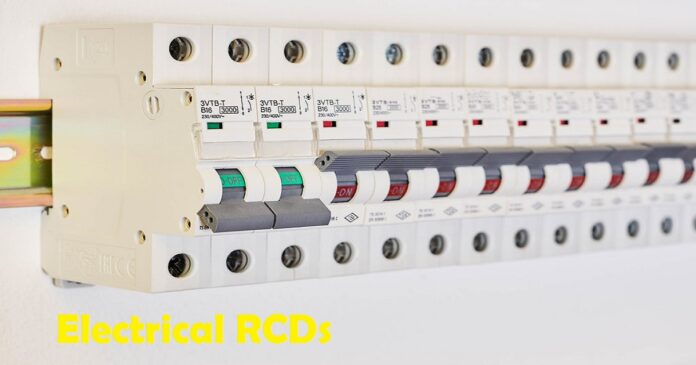What is an RCD Electrical equipment?
An electrical RCD, or Residual Current Device, is life-saving equipment designed to prevent electrocution. It quickly disconnects the power supply if it detects an imbalance in the current flowing through the circuit. RCDs are an essential safety feature in any electrical installation and are required by law in many countries. The working principle of RCD is the monitoring of the flow of electricity in a circuit. If the current becomes too high or the current leaks, the RCD will trip and cut off the power supply.
This article serves as a guide that will provide all necessary information relating to RCD electrical equipment (Residual current devices) like their different types, construction, working of RCDs, and their application in different industries.
Working of RCDs explained

RCDs work by constantly monitoring the current flow in a circuit and immediately shutting off the power if they detect an imbalance. Electrical issues can be caused by a ground fault, such as when someone comes into contact with a live wire. RCDs help provides safety in case of fires and shocks and can save lives in the event of an electrical accident.
It’s a good idea to install an RCD in your home or office because they protect against electrocution. When an RCD trips, it cuts off the flow of electricity and prevents dangerous currents from flowing through the body. The importance of RCDs cannot be overstated, and they’re an essential safety feature in any electrical installation.
RCDs need to be regularly tested. For this activity, a simple tester plugged into the socket can work. If the RCD trips, it is working correctly and providing vital protection.
Types of RCDs electrical equipment

RCDs typically have the following functions: those that measure the current flowing through the live and neutral wires and those that measure the current flowing through the earth wire. The latter is more sensitive and therefore provides a higher level of protection.
The three main types of RCDs: AC, DC, and AC/DC. AC RCDs work by sensing when the current flowing through an electrical circuit is imbalanced. DC RCDs work similarly, but they are designed for use with direct current circuits. AC/DC RCDs can be used with both types of circuits.
Following are the different types of RCDs based on their categorization as AC, DC, and AC/DC types, which are;
- Fixed RCD
- Socket Outlet RCD
- Portable RCD
- Type AC
- Type A
- Type B
- Type F
Fixed RCDs
Fixed RCDs are hard-wired into the electrical system and cannot be turned off. These features of fixed RCDs can make them ideal for protecting against ground faults, as they will always be ready to respond if there is an issue. However, fixed RCDs can also be used in other ways to protect over currents. Fixed RCDs are a versatile and essential part of any electrical system.
Socket-Outlet RCDs
Socket-Outlet RCDs is an electrical safety device designed to protect people from electrocution. They function by checking up on an electrical circuit’s current flow and shutting off the power if they notice an imbalance. If someone touches a live wire or there is a wiring fault, this could happen.
Both household and business settings are suitable to use with this kind of RCD. The outlets protect you from electricity by shock and fire. At the same time, they are not foolproof and can sometimes trip when there is no danger.
Portable RCDs
Portable RCD is a plug-in standard socket-outlet RCD is a device that provides a high level of protection for electronic equipment. It is also called “portable RCD.” This type of RCD is designed with not permanently installed equipment, such as portable power tools, extension cords, and portable generators.
Portable RCDs are typically used in construction sites, factories, and other industrial settings where there is a risk of electrical shocks. These devices can also be used in residential settings, such as garages and workshops, to protect users from shocks while working on electrical equipment.
Type AC
RCDs come in various types, with the most common being Type AC. Type AC RCDs are designed with alternating current (AC) and are suitable for domestic and light commercial environments. They can detect both live and neutral conductor currents and will trip if the current differences exceed a specific threshold value. This property of Type AC RCDs makes them highly effective at protecting against electrical shocks.
Type A
Type A Electrical RCDs are essential for ensuring the safety of your electrical circuits. Type A RCDs are designed with alternating current (AC) circuits typically used in homes and businesses. To get the best one for your needs, they come in a range of amperages. Always make sure that the amperage of your circuit is correct for what you are trying to do. If necessary, a qualified electrician can offer help with this option. Remember, Type A RCDs are essential for keeping your electrical circuits safe.
Type F
An F type Electrical RCD is a device used to protect air conditioners and single-phase motors against overcurrent. The device is installed in the air conditioner’s circuit breaker panel and is connected to the air conditioner’s power supply. This RCD monitors the air conditioner’s current and trips the air conditioner’s circuit breaker if the current exceeds the RCD’s trip point.
It will also protect the air conditioner’s motor if it is turned off. If the air conditioner has a three-phase motor, the RCD will not protect the air conditioner’s motor. The F-type electrical RCDs are UL listed, and CSA certified.
Type B
A type B residual current device is a current-sensing air conditioner used to protect against single-phase motor burnout due to sinusoidal AC or pulsating DC in the air conditioner’s windings. The air conditioner’s cooling coils are copper or aluminum, and the windings are wound around them. The air conditioner contains a capacitor connected in parallel with the air conditioner’s winding. The capacitor stores energy and releases it when the air conditioner’s winding is energized, allowing the air conditioner to continue running for a short time after the power is turned off.
Type B RCDs are designed to be used with single-phase motors protected by fuses. The RCD will sense the current in the motor’s winding and shut off the motor’s power if the current exceeds a predetermined level. This protects the motor from burning out due to excessive current. Type B RCDs come in a variety of sizes and ratings.
Read More: A Detailed Guide About How Long Does A Car Battery Last Without Driving?
What is an RCD protection?

RCD protection is a device used in electrical circuits to prevent electrocution and electrical fires. An RCD protection is an ideal way to safeguard homes from dangerous fires. These devices can be fitted at fuse boards or individually installed with integrated protection on each socket to ensure that there will never again be any danger when it comes time for repair work.
RCDs are typically used with other safety devices, such as circuit breakers to provide complete protection.
A Residual Current Device is a sensitive safety device that immediately turns off the power in the event of an electrical accident. An RCD is made to guard against the dangers of fire and electrocution brought on by the earth’s faults. Protective RCDs are a common feature in electrical systems. They are made to swiftly interrupt electrical circuits, protecting the user from major electrical shock injuries.
Application of Electrical RCDs in different fields
Electrical RCDs (Residual Current Devices) are vital safety devices increasingly being used in a wide range of applications to protect people and equipment from electric shock.
RCDs can be used in domestic, commercial, and industrial settings and are particularly important in areas with a risk of electrocution, such as bathrooms and outdoors. In addition to their life-saving potential, RCDs also help protect equipment from damage by reducing the risk of fire and electrical shocks. As a result, they are an essential part of any electrical installation.
Domestic RCDs are often used in homes and workplaces to protect against shock hazards. Industrial RCDs are used in high voltage applications, such as the power system for a factory. They can be installed alone or with other safety devices like fuse boxes and circuit breakers to protect against accidents.
Final Words
Electrical RCDs provide an essential safety function in homes and businesses. By understanding how they work, you can be better prepared to use them safely and effectively when needed.









